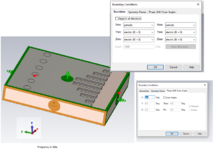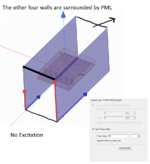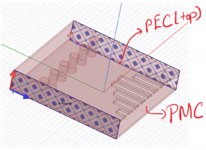KeysorSoze
Newbie level 4
Hi,
I am trying to perform eigenmode simulation to obtain dispersion diagram for a paper "https://ieeexplore.ieee.org/stamp/stamp.jsp?tp=&arnumber=9055410" Figure 3 (b), but I am not getting the desired result. I have tried performing the simulations in both HFSS and CST and the summary ppt (of errors) along with simulation models (.zip) is attached.
In CST, I have applied periodic boundary condition (with parametric sweep of phase angle difference between the periodic boundaries) in the direction of the guiding structure and the other two boundaries as Electric, but as it turns out the eigenmode are obtained for a waveguide created due to via-walls and electric boundary condition I give (explained in PPT). Hence dispersion diagram is similar to a waveguide. Essentially, I want to figure out the boundary conditions.
I have also attached the simulation model in HFSS in case that is required.
Any help or ideas will be appreciated
I am trying to perform eigenmode simulation to obtain dispersion diagram for a paper "https://ieeexplore.ieee.org/stamp/stamp.jsp?tp=&arnumber=9055410" Figure 3 (b), but I am not getting the desired result. I have tried performing the simulations in both HFSS and CST and the summary ppt (of errors) along with simulation models (.zip) is attached.
In CST, I have applied periodic boundary condition (with parametric sweep of phase angle difference between the periodic boundaries) in the direction of the guiding structure and the other two boundaries as Electric, but as it turns out the eigenmode are obtained for a waveguide created due to via-walls and electric boundary condition I give (explained in PPT). Hence dispersion diagram is similar to a waveguide. Essentially, I want to figure out the boundary conditions.
I have also attached the simulation model in HFSS in case that is required.
Any help or ideas will be appreciated







